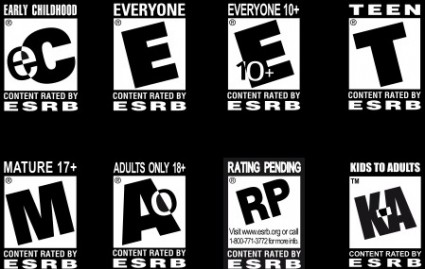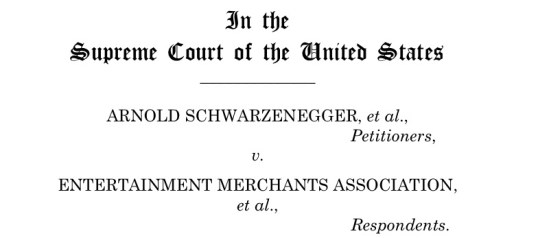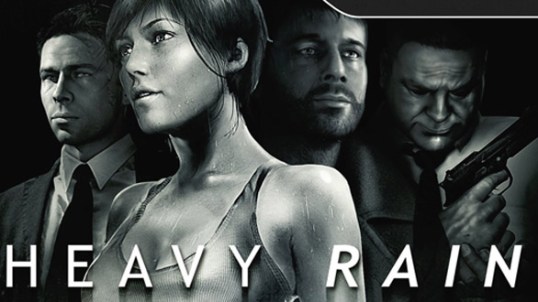When the Supreme Court of the United States hears opening statements for “Schwarzenegger v. Entertainment Merchants Association” this Tuesday, the video game medium will face its most epic boss battle ever. The court case concerns California Civil Code 1746-1746.5, which prohibits the sale or rental of games that portray “killing, maiming, dismembering or sexually assaulting an image of a human being” to people younger than 18 years old. The key issue is whether the “violent video game law,” as it’s also known, is unconstitutional by way of impinging on free speech.
Written by California politician Leland Yee, the legislation began as California Assembly Bills 1792 & 1793 and was signed into law in 2005. The highest court in the land will decide on the constitutionality of the statute and the SCOTUS ruling could influence the fates of game developers and would-be players alike. As it currently stands, the law exacts a $1000 fine for each instance where an M-rated game is sold to a minor. To get some perspective on what hangs in the balance, we spoke with Joseph Olin, President Emeritus of the Academy of Interactive Arts and Sciences. The organization was founded in 1996 and serves to build awareness of the breadth and depth of video game creativity.
The AIAS, along with the International Game Developers Association, has submitted an amicus brief to provide context for the nine Justices of SCOTUS. The document–also known as a “friend of the court” brief– proffers that video games are a form of artistic expression that deserve the same protections afforded to film, books or music. Olin’s held the position of president since 2004 and will be stepping down at year’s end and, in the interview that follows, he talks about what’s at stake in the upcoming court case.
With Schwarzenegger v. EMA going before the Supreme Court this week, I wanted to ask you about the repercussions could happen on two levels. A decision that upholds the law will obviously have legal and financial consequences rippling out for developers and retailers. And it also seems like a broader cultural impression could be left on the minds of the uninitiated. Can you talk about how you see these things playing out?
You’re essentially asking for a “what if?” scenario. And that’s a natural thing, because I think that most of the creative and financial stakeholders of the interactive entertainment industry are still sort of mystified. Mystified that the state of California, through the Governator and attorney general Jerry Brown, were successfully able to have the Supreme Court hear this case.
There’s 17 other instances where the EMA/ESA (Entertainment Software Association) have successfully had comparable rules struck down or ruled unconstitutional on a state level. No one really wants to think about the consequences of a decision by the courts to overturn the appellate ruling on the Yee bill. On a corporate level, on a creative, on an independent development level, you can’t really do anything until you know what it is you have to do. Ultimately, I think that the biggest flaw within the Yee bill is that it doesn’t give you any hard points to make decisions about.
Right. It would be one thing to say, OK, this kind of content is unacceptable. It’s a danger to consumers.
I think the easy metaphor is the way we legislate and regulate tobacco and alcohol against from underage drinking and smoking. You can usually read every month which local merchants and bars that have sold alcohol to underage kids and how they’ve been busted. They pay significant fines and can lose their licenses. And the same thing with tobacco. If a drugstore goes in there and sells to Debbie, who looks like she’s 18. That’s a hard point. It’s a black-and-white situation. It makes it very difficult to get around the extant laws.
The Yee bill offers very little guidance on how to avoid running afoul of it. That’s not new. If you look at the history of media, film was a difficult thing to regulate on the states and the country levels. It’s why the Hays Commission was formed, and then we go the Hays Code in 1932, which outlined what was unacceptable. That stood until 1952, when before film was finally granted first amendment protection by the Supreme Court with Joseph Burstyn, Inc. v. Wilson.
And that was about 30 years after its inception as a popular media, about the same place that games are at now.
Correct. And film had missed protection in previous iterations on both federal and local levels. Part of it what changed was the passage of time, which adds context. And the other part of it was really, I think, people’s acceptance of film as a form of cultural expression. Just because something was created from a commercial perspective doesn’t mean that it doesn’t enjoy the same levels of protection than any other artform does.
How much do you feel like Schwarzenegger, Brown, and Yee, prey on a certain amount of cultural ignorance about video games? You think that’s a conscious decision that they’re making in their strategy?
That would be certainly one school of thought. Having listened to Senator Yee speak before, there’s no doubt that he’s got intellect. He just has a particular perspective that comes from his training as a child psychologist, where he feels that hyper-violent images have causal properties to young children. And that’s fine to believe that. And as a parent, Leland Yee should be able to say, I don’t want my children to play these games, so they can’t. End of story. It should start and end there.
In the same way, I’m a parent of three, who have thankfully all survived their adolescence and their downloading of a variety of things to their personal computers. All that was regulated by my filtering software or the blocking of MAC addresses until they got the point. It’s my job as a parent. I don’t expect anyone else to do that for me. So, that’s a fundamental thing here. I don’t think that Leland Yee was doing this as a grandstand play or because he has designs to be the next governor or senator from the state of California or to go onto a national thing. He did it because he fundamentally believes it.
Sounds like you have some grudging respect for him…
I respect that he can have his beliefs, in the same way the constitution allows you to have yours and me to have mine. But the other side, with Governor Schwarzenegger, I think there’s definitely some politics in his involvement.
Do you see a contradiction in Schwarzenegger being attached to this legislation, given that his entertainment career was predicated on hyper-violent entertainment?
Yes, I do. He’s been the lead in lots of films with violence that’s no ifferent thatn what’s found in games. With this bill and the supposed violent video game issue, he doesn’t necessarily gain anything politically in the short term, either, because he’s not up for election. It’s hard to fathom his motivation. Yes, he can run for the Senate in another six years assuming he has any political currency but that’s a ways off.
Nevertheless, he is certainly gravitated towards the issue. He has always supported this bill, going back to when Yee first brought it the assembly. So, there’s a big contradiction. Arnold was paid handsomely, to say the least, for his portrayal as the Terminator, let alone all of his other violent movies, even the forgettable ones like Eraser.
Yeah. Total Recall is not a walk through the park.
There were only 30, 40, 50, 60, 70, 80 people that he killed in 90 minutes. [Laughs]
Part of the problem with the regulatory debate is the fact that the Entertainment Software Rating Board already exists. It labels every game release with the age range it’s appropriate for, and Everyone (E), Teen (T) or Mature (M) are the most common categories. But, pro-regulation advocates have said that the ESRB is a paper tiger that can’t really stop minors from getting at stuff that they probably shouldn’t be playing. What would you say to the people who criticize the systems that are already in place to regulate content?
Well, I think that the best systems to regulate content are in the homes of people across America. Full stop. That’s it. Don’t blame content creators or artists because some parents shirk their responsibilities or are just disinterested.
But even so, the ESRB provides a baseline of description and so much guidance that even the most ignorant of consumers can at least say, “Oh, I’m about to buy a game that says ‘M’ on it for my seven-year-old!” From there, they should be able to caution themselves accordingly. The ESRB does this for all sorts of games, just about any of the games that are marketed at retail. So, for parents who ignore the warnings, the fact that they elect not to heed them is their right. It doesn’t diminish the point that that guidance does, in fact, exist. If I think that my 12-year-old is mature enough, I’ll let him play Red Dead Redemption, but that’s my choice as a parent. And I think that the ESRB still doesn’t get enough credit within the legislative halls, as being a very strong benchmark for the types of content that’s available. And it should just be that–a benchmark. It should not be the recommending body as to what’s safe or what isn’t safe, because that’s such an impossible moving target.
Yeah, it’s a subjective judgment as to what’s okay for which person. But, because M-rated games are in the crosshairs of that bill, do you think we might see that whole category of experiences disappear all together if the law gets upheld?
Well, I don’t think it will disappear. I think the market may bifurcate to the point where the things that you find on display at retail are going to be the E, E+ categories and maybe a few key releases. For everything else, it’s going to be like porn. It’s going to be under lock and key behind a curtain someplace. And you’re going to have to show your ID. Otherwise, it will get moved to the Web where you can lie discretely about what your age is.
That seems to me to be a far more porous system than having some gate-keeping at retail or in the distribution process, as it currently stands.
Exactly. If you want to play a promotion on the Budweiser site for their NFL program, the first thing they ask you when you get to the splash, of course, is to state your age. I don’t know anyone over the age of 10 who doesn’t know how to figure out how to be 21.
Yeah, that’s very true.
So I don’t think that’s the answer. I think that the immediate effect is going to be a lot of independent studios choosing to be very cautious and the funding parties–whether they’re publishers or independent financial arms–will really caution themselves about sponsoring M-rated games, or even T-rated games.
Most times, game development studios are looking for funding commitments with a paper document or some sort of light playable prototype before the really significant dollars get spent. But ultimately, you’re not going to know what the rating is until long after the thing is done. When you submit it to the ESRB, they actually have their people play through it and then you get your rating
And, depending on what you get, your whole marketing plan–and the fate of the project essentially–could be screwed.
Right. The ESRB does a very good job of providing what I’d call it usable feedback to publishers and developers as far as what they find in a game. Developers can know why they gave this game the rating of an M as opposed to a T.
The ESRB just literally slots game releases between levels of violence, and then ranks them as to what’s acceptable or not acceptable between the rating bands. There’s never a wholesale judgment that says that it’s unacceptable as a form of content. The labels are a form of guidance, not a referendum on the appropriateness of the experience a game provides.
Even if Yee and his camp had their way, it’s tough to even imagine that a federal or state body could tasked to judge appropriateness.
 Right. But here’s where we run up against the fallacious positions of people against games, because there’s not a successful compelling precedent for the government policing content. The Motion Picture Association of America under Jack Valenti started their ratings system to avoid direct government intervention. And the government was wisely not really interested in being a ratings board, so this was the happy medium. As a result, it’s very difficult to get around the Motion Picture Association of America, and to find anyone who will display a film to consumers that isn’t rated by the MPAA. In the same way, it’s very difficult to find a retailer who will take a box that doesn’t have the ESRB ratings on it. Self-policing works.
Right. But here’s where we run up against the fallacious positions of people against games, because there’s not a successful compelling precedent for the government policing content. The Motion Picture Association of America under Jack Valenti started their ratings system to avoid direct government intervention. And the government was wisely not really interested in being a ratings board, so this was the happy medium. As a result, it’s very difficult to get around the Motion Picture Association of America, and to find anyone who will display a film to consumers that isn’t rated by the MPAA. In the same way, it’s very difficult to find a retailer who will take a box that doesn’t have the ESRB ratings on it. Self-policing works.
The bst example is probably when the Hot Coffee scandal broke in Grand Theft Auto: San Andreas. The game temporarily had the Adults Only (AO) rating and big box retailers like Wal-Mart would not carry the game. But, with a court decision being handed down, it seems like that’s another potential repercussion of the case would be a kind of tacit stamp that renders the whole video game medium as acceptable or not. Can you talk a little bit more about what could happen?
I don’t know that culture is going to change. The people who have pre-ordered five million copies of Call of Duty: Black Ops, and the million-plus people who are playing Medal of Honor right now, I don’t think they’re going to all of sudden not ever want to play a game that is intrinsically violent by virtue of its storyline or game mechanics. If games are banned outright, all these people would basically be playing the same games that they have right now online until the servers melted. So, I think that what potentially can happen is that people will be more selective in terms of the concepts.
But, there’s only a market for M-rated games because consumers want that. In television, I personally don’t think much of Two and a Half Men as a form of entertainment. But, I get the fact that 20 million Americans watch it every week, which is scary. Still, I can appreciate Jackass 3D. Those were all the things that I thought about doing when I was like 12. They’re just hysterical. They really are. Do I think that’s great quality entertainment? No. Is it a fabulous use of film as an artistic medium? No. Likewise, there’s no shortage of examples of games that aren’t cultural expressions of the highest order. But that’s all right, because you have things like Mass Effect 2 or Heavy Rain that really stretch what the medium can deliver to a consumer as an experience.
The marketplace can live with both. We’ll have restrictions, perhaps. It just means that there will be different ways to distribute different things. It will probably mean that the direct relationships with publishers and developers–that can now be had thanks to the Internet and broadband connected consoles– may shift this content away from the big box stores to a different stage.
Do you think that if the Supreme Court strikes down the appellate decision, it could re-ignite the whole demonization of video games as a medium, as this cultural kind of blight?
No. There’s two-thirds of American households that have game consoles and game systems in them. You have 175 million mobile devices, all with games on them. You have on any given day, 30 million people playing a Zynga game on Facebook.
Games aren’t going away. Such a decision would just mean that how they’re consumed–in terms of the physical transaction point–may change. And, as I understand it from the attorneys that we work with, if the Supreme Court strikes down the appellate ruling, it’s only for the state of California. It’s a California bill. It doesn’t mean that the other 49 states can immediately enact this.
They would still have to draft something and go through the approval process.
Right. It took, what, two years before the Yee bill was finally signed? So it’s not an overnight process. Obviously, in some states, it can happen more quickly than others. And that means that the Entertainment Software Association (ESA) and the EMA and other lobbying groups are going to have to do a better job of managing video games’ reputation to all these different legislatures.
This is where an organization like the Video Game Voters Network, I think, can really serve a higher purpose in trying to motivate players to let their legislatures know that they play games. That games are fine and fun, and are as legitimate a form and expression of entertainment and art as anything else. So leave them the hell alone. They’d craft the message slightly differently, I’m sure. [laughs]
It’s kind of a standard media consumption argument, isn’t it? The most telling thing about the letter Stan Lee wrote for the Video Game Voters Network was him saying, essentially, “I’ve seen this before.” And you can say what you want about comic books and their merits as an art form, but the parallels are very similar.
I’ve written about that, too. There’s nothing to say that, because your creative content is disposable on a certain level, that it lacks artistic merit. I mean, comics weren’t created to be art. Stan Lee wrote things to get paid. It took a generation to live and die before he was considered a celebrated artist. He was always respected as a great comic creator. But “artist” and “comic creator” were not used in the same sentence during his heyday when he was creating these things with his partners. In comparison, games get some of the benefit of a more open mindset today than comics did 30 years ago.
Yeah, there’s more acceptance but there’s still a certain amount of trepidation probably too. Who knows, if ever, the last time Scalia or Sotormayor picked up a game controller?
It’s one of the reasons why we cited some examples of how games have changed in the Academy’s brief, We go into how they’re different and how their production requires comparable creativity, skill sets and technologies as film does. The amicus brief also notes that there are so many people in film who are creating games or are part of the process of creating games. So if you’re allowing them a free pass in film, their work in games should get one too.
On that point, I spoke with Danny Bilson at the unveiling of THQ’s new Montreal studio and he told me that games are actually his favorite medium right now. He grew up in movies. and is a third-generation movie person. So that was very telling to hear him say that. If you had to present, let’s say five games, to the Supreme Court, to kind of validate the artistic merit of the medium, what would they be?
We actually did that in our brief. We started out with a list of 120 games.
Wow. And you narrowed it down to five?
Four, actually, because the amicus briefs have a hard word count. So, as we’re going through the process with the attorneys to change wording and add extra support points, the attorneys’ crafting the brief points are saying, “Now we’re over, so what are we cutting?”
I get that from editors, too…
So, we had no shortage of games that we thought demonstrated different aspects of games as culture. But, we were directed by our attorneys–and by Jenner and Block, who is representing the ESA and EMA before the court–to stick with what they thought would have the greatest traction within the way the Supreme Court works, in terms of the examples that they wanted. Because going before the Supreme Court is not like filing and going before a lower court. It’s not like anything we see on TV. The rules of the Supreme Court are completely different, and learning that was eye-opening. Anything that’s been said and used as evidence in the lower courts, you can’t mention again, because it’s already on the record.
Oh, you’ve got to present entirely new stuff.
So, it all has to be new and you can’t use the same witnesses. Once your witness has spoken, that’s it. Once you’ve been excused on the stand, you’re really excused. And, by the way, amicus briefs can only be submitted in a certain format–they look like little digest-sized things–and they have to be bound a certain way, with only two staples not three.
That’s really bizarre.
So, it wasn’t a challenge to find examples of games as artistic expressions. The challenge was to explain the examples in a way that somebody from Mars who’s never really played a modern game would be able to see that there’s something more to this medium. Games that defied the typical banter that says games are just violent, mind-wasting exercises done to steal money from young children.
The four that made the cut were Red Dead Redemption, Assassin’s Creed II, Heavy Rain, and BioShock.
Good calls, all of them.
I was happy with all of those. I was really arguing to include The Lord of the Rings games, just because it’s something that’s lived successfully from print to the big screen to video games. It’s been imagined differently every time and it was pretty fantastic when Peter Jackson brought all those lands and creatures and battles to the screens. However, the games find a different way to enjoy that same material. And it was the crossover of talent between movie and game that we thought was a good example. But, ultimately LOTR got dropped out because we wanted to really focus on game franchises that were games first, as opposed to ones inspired from other mediums.






